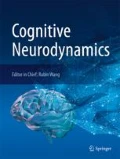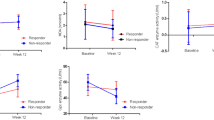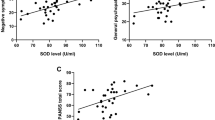Abstract
Accumulating evidence suggest that excessive reactive oxygen species-induced oxidative damage may underlie neurodegeneration and cognitive impairment in several disorders including schizophrenia. In this study we examined the association of oxidative stress with cognitive deficits in first-episode drug-naïve (FEDN) patients with schizophrenia. We recruited 54 FEDN patients and 50 age- and sex-matched healthy controls and examined the Measurement and Treatment Research to Improve Cognition in Schizophrenia Consensus cognitive Battery (MCCB) and plasma total antioxidant status (TAS). Psychopathological symptoms were assessed using the Positive and Negative Syndrome Scale. The results showed that plasma TAS levels were significantly lower in the patients than those in the healthy subjects (94.7 ± 25.0 U/ml vs 156.6 ± 46.7 U/ml, p < 0.0001). The patients scored lower than healthy controls on the MCCB total score, speed of processing, attention/vigilance and managing emotion test index and STROOP test. For the patients, TAS was associated with some domains of cognitive deficits in schizophrenia, such as speed of processing, attention/vigilance and emotion managing. Our results suggested that oxidative stress may be involved in the pathophysiology of schizophrenia at the early of stage and its cognitive impairment.
Similar content being viewed by others
Abbreviations
- ANOVA:
-
Analysis of variance
- ATD:
-
Acute tryptophan depletion
- BVMT:
-
Brief Visuospatial Memory Test
- FEDN:
-
First-episode drug-naïve
- FEP:
-
First-episode patients
- FRAP:
-
Ferric reducing antioxidant potential
- HVLT:
-
Hopkins Verbal Learning Test
- LTP:
-
Long time potentiation
- MCCB:
-
Measurement and Treatment Research to Improve Cognition in Schizophrenia Consensus cognitive Battery and plasma
- MSCEIT:
-
Mayer–Salovey–Caruso Emotional Intelligence Test
- NAB:
-
Neuropsychological assessment battery
- OS:
-
Oxidative stress
- PANSS:
-
Psychopathological symptoms were assessed using the Positive and Negative Syndrome Scale
- ROS:
-
Reactive oxygen species
- SCID:
-
Structured clinical interview for DSM-IV
- TAS:
-
Total antioxidant status
- TPTZ:
-
Tripyridyl triazine
References
Akiibinu MO, Ogundahunsi OA, Ogunyemi EO (2012) Inter-relationship of plasma markers of oxidative stress and thyroid hormones in schizophrenics. BMC Res Notes 5:169
Alvarez JA, Emory E (2006) Executive function and the frontal lobes: a meta-analytic review. Neuropsychol Rev 16(1):17–42
An H, Du X, Huang X et al (2018) Obesity, altered oxidative stress, and clinical correlates in chronic schizophrenia patients. Transl Psychiatry 8(1):258
Barch DM, Carter CS, Arnsten A et al (2009) Selecting paradigms from cognitive neuroscience for translation into use in clinical trials: proceedings of the third CNTRICS meeting. Schizophr Bull 35(1):109–114
Barder HE, Sundet K, Rund BR et al (2013) Neurocognitive development in first episode psychosis 5 years follow-up: associations between illness severity and cognitive course. Schizophr Res 149(1–3):63–69
Benzie IFF, Strain JJ (1996) The ferric reducing ability of plasma (FRAP) as a measure of “antioxidant power”: the FRAP assay. Anal Biochem 239(1):70–76
Bitanihirwe BK, Woo TU (2011) Oxidative stress in schizophrenia: an integrated approach. Neurosci Biobehav Rev 35(3):878–893
Boskovic M, Vovk T, Plesnicar BK, Grabnar I (2011) Oxidative Stress in Schizophrenia. Curr Neuropharmacol 9(2):301–312
Dalby RB, Frandsen J, Chakravarty MM et al (2012) Correlations between Stroop task performance and white matter lesion measures in late-onset major depression. Psychiatry Res 202(2):142–149
Davies KJ (2000) An overview of oxidative stress. IUBMB Life 50(4–5):241–244
Erlenmeyer-Kimling L (2000) Neurobehavioral deficits in offspring of schizophrenic parents: liability indicators and predictors of illness. Am J Med Genet 97(1):65–71
Flatow J, Buckley P, Miller BJ (2013) Meta-analysis of oxidative stress in schizophrenia. Biol Psychiat 74(6):400–409
Gahtan E, Auerbach JM, Groner Y et al (1998) Reversible impairment of long-term potentiation in transgenic Cu/Zn–SOD mice. Eur J Neurosci 10(2):538–544
George A, Ng CP, O’Callaghan M et al (2014) In vitro and ex vivo cellular antioxidant protection and cognitive enhancing effects of an extract of Polygonum minus Huds (Lineminus) demonstrated in a Barnes Maze animal model for memory and learning. BMC Complement Altern Med 14:161
Green MF, Nuechterlein KH (2004) The MATRICS initiative: developing a consensus cognitive battery for clinical trials. Schizophr Res 72(1):1–3
Green MF, Horan WP, Lee J (2015) Social cognition in schizophrenia. Nat Rev Neurosci 16(10):620–631
Gunes M, Camkurt MA, Bulut M et al (2016) Evaluation of paraoxonase, arylesterase and malondialdehyde levels in schizophrenia patients taking typical, atypical and combined antipsychotic treatment. Clin Psychopharmacol Neurosci 14(4):345–350
Halliwell B (2006) Oxidative stress and neurodegeneration: where are we now? J Neurochem 97(6):1634–1658
Harvey PD (2014) What is the evidence for changes in cognition and functioning over the lifespan in patients with schizophrenia? J Clin Psychiatry 75(Suppl 2):34–38
Hu HL, Wang T, Zhang ZX et al (2006) The effect of mitochondrial membrane potential on changes of reactive oxygen species and on proliferation of hypoxic human pulmonary arterial smooth muscle cells. Zhonghua jie he he hu xi za zhi = Chin J Tuberc Respir Dis 29(11):727–730
Irani F, Kalkstein S, Moberg EA et al (2011) Neuropsychological performance in older patients with schizophrenia: a meta-analysis of cross-sectional and longitudinal studies. Schizophr Bull 37(6):1318–1326
Keefe RS, Harvey PD, Goldberg TE et al (2008) Norms and standardization of the Brief Assessment of Cognition in Schizophrenia (BACS). Schizophr Res 102(1–3):108–115
Keefe RS, Fox KH, Harvey PD et al (2011) Characteristics of the MATRICS consensus cognitive battery in a 29-site antipsychotic schizophrenia clinical trial. Schizophr Res 125(2–3):161–168
Kern RS, Gold JM, Dickinson D et al (2011) The MCCB impairment profile for schizophrenia outpatients: results from the MATRICS psychometric and standardization study. Schizophr Res 126(1–3):124–131
Kim JH, Lee J, Kim YB et al (2014) Association between subjective well-being and depressive symptoms in treatment-resistant schizophrenia before and after treatment with clozapine. Compr Psychiatry 55(3):708–713
Kohen R, Nyska A (2002) Oxidation of biological systems: oxidative stress phenomena, antioxidants, redox reactions, and methods for their quantification. Toxicol Pathol 30(6):620–650
Kolosova NG, Shcheglova TV, Sergeeva SV et al (2006) Long-term antioxidant supplementation attenuates oxidative stress markers and cognitive deficits in senescent-accelerated OXYS rats. Neurobiol Aging 27(9):1289–1297
Li HC (2006) Imbalanced free radicals and antioxidant defense systems in schizophrenia: a comparative study. J Zhejiang Univ Sci B 7(12):981–986
Li XF, Zheng YL, Xiu MH et al (2011) Reduced plasma total antioxidant status in first-episode drug-naive patients with schizophrenia. Prog Neuropsychopharmacol Biol Psychiatry 35(4):1064–1067
Lohr JB, Kuczenski R, Niculescu AB (2003) Oxidative mechanisms and tardive dyskinesia. CNS Drugs 17(1):47–62
Mace J, Porter R, O’Brien J et al (2008) Cognitive effects of acute tryptophan depletion in the healthy elderly. Acta Neuropsychiatrica 20(2):78–86
Martinez-Cengotitabengoa M, Mac-Dowell KS, Leza JC et al (2012) Cognitive impairment is related to oxidative stress and chemokine levels in first psychotic episodes. Schizophr Res 137(1–3):66–72
Massaad CA, Klann E (2011) Reactive oxygen species in the regulation of synaptic plasticity and memory. Antioxid Redox Signal 14(10):2013–2054
McCleery A, Ventura J, Kern RS et al (2014) Cognitive functioning in first-episode schizophrenia: MATRICS consensus cognitive battery (MCCB) profile of impairment. Schizophr Res 157(1–3):33–39
Mendoza-Nuñez VCM, Retana-Ugalde R, Sánchez-RodríGuez MA et al (1999) DNA damage in lymphocytes of elderly patients in relation with total antioxidant levels. Mech Ageing Dev 108(1):9–23
Mendoza-Núñez VCM, Retana-Ugalde R, Vargas-Guadarrama LA et al (2001) Total antioxidant levels, gender, and age as risk factors for DNA damage in lymphocytes of the elderly. Mech Ageing Dev 122(8):835–847
Miljevic CD, Nikolic-Kokic A, Blagojevic D et al (2018) Association between neurological soft signs and antioxidant enzyme activity in schizophrenic patients. Psychiatry Res 269:746–752
Miller NJ, Rice-Evans C, Davies MJ et al (1993) A novel method for measuring antioxidant capacity and its application to monitoring the antioxidant status in premature neonates. Clin Sci 84(4):407–412
Mintz J, Kopelowicz A (2007) CUtLASS confirms CATIE. Arch Gen Psychiatry 64(8):978
Nicolle MM, Gonzalez J, Sugaya K et al (2001) Signatures of hippocampal oxidative stress in aged spatial learning-impaired rodents. Neuroscience 107(3):415–431
Nieuwenstein MR, Aleman A, Haan EHFD (2001) Relationship between symptom dimensions and neurocognitive functioning in schizophrenia: a meta-analysis of WCST and CPT studies. J Psychiatr Res 35(2):119–125
Ozcan ME, Gulec ME, Polat R et al (2004) Antioxidant enzyme activities and oxidative stress in affective disorders. Int Clin Psychopharmacol 19(2):89–95
Padurariu M, Ciobica A, Dobrin I et al (2010) Evaluation of antioxidant enzymes activities and lipid peroxidation in schizophrenic patients treated with typical and atypical antipsychotics. Neurosci Lett 479(3):317–320
Palmer BW, Dawes SE, Heaton RK (2009) What do we know about neuropsychological aspects of schizophrenia? Neuropsychol Rev 19(3):365–384
Poo MM (2001) Neurotrophins as synaptic modulators. Nat Rev Neurosci 2(1):24–32
Radak Z, Kumagai S, Taylor AW et al (2007) Effects of exercise on brain function: role of free radicals. Appl Physiol Nutr Metab 32(5):942–946
Raffa M, Atig F, Mhalla A et al (2011) Decreased glutathione levels and impaired antioxidant enzyme activities in drug-naive first-episode schizophrenic patients. BMC Psychiatry 11:124
Rajji TK, Mulsant BH (2008) Nature and course of cognitive function in late-life schizophrenia: a systematic review. Schizophr Res 102(1–3):122–140
Rajji TK, Voineskos AN, Butters MA et al (2013) Cognitive performance of individuals with schizophrenia across seven decades: a study using the MATRICS consensus cognitive battery. Am J Geriatr Psychiatry 21(2):108–118
Rajji TK, Miranda D, Mulsant BH (2014) Cognition, function, and disability in patients with schizophrenia: a review of longitudinal studies. Can J Psychiatry 59(1):13–17
Ramos-Chavez LA, Roldan-Roldan G (2018) Low serum tryptophan levels as an indicator of global cognitive performance in nondemented women over 50 years of age. Oxid Med Cell Longev 2018:8604718
Reddy R (2003) Reduced plasma antioxidants in first-episode patients with schizophrenia. Schizophr Res 62(3):205–212
Ruiz-Litago F, Seco J, Echevarria E et al (2012) Adaptive response in the antioxidant defence system in the course and outcome in first-episode schizophrenia patients: a 12-months follow-up study. Psychiatry Res 200(2–3):218–222
Stuss DT, Floden D, Alexander MP et al (2001) Stroop performance in focal lesion patients: dissociation of processes and frontal lobe lesion location. Neuropsychologia 39(8):771–786
Tan SP, Jie-Feng C, Fan FM et al (2014) Smoking, MATRICS consensus cognitive battery and P50 sensory gating in a Han Chinese population. Drug Alcohol Depend 143:51–57
Valko M, Leibfritz D, Moncol J et al (2007) Free radicals and antioxidants in normal physiological functions and human disease. Int J Biochem Cell Biol 39(1):44–84
Virit O, Altindag A, Yumru M et al (2009) A defect in the antioxidant defense system in schizophrenia. Neuropsychobiology 60(2):87–93
Wang N, Wei J, Liu Y et al (2016) Discovery of biomarkers for oxidative stress based on cellular metabolomics. Biomarkers 21(5):449–457
Wu Z, Zhang XY, Wang H et al (2012) Elevated plasma superoxide dismutase in first-episode and drug naive patients with schizophrenia: inverse association with positive symptoms. Prog Neuropsychopharmacol Biol Psychiatry 36(1):34–38
Wu JQ, da Chen C, Tan YL et al (2014) Cognition impairment in schizophrenia patients with tardive dyskinesia: association with plasma superoxide dismutase activity. Schizophr Res 152(1):210–216
Yao JK, Keshavan MS (2011) Antioxidants, redox signaling, and pathophysiology in schizophrenia: an integrative view. Antioxid Redox Signal 15(1):2011–2035
Yao JK, Reddy R (2011) Oxidative stress in schizophrenia: pathogenetic and therapeutic implications. Antioxid Redox Signal 15(7):1999–2002
Yao JK, Reddy R, Van Kammen DP (1998) Reduced level of plasma antioxidant uric acid in schizophrenia. Psychiatry Res 80(1):29–39
Zhang XY, Chen DC, Xiu MH et al (2012a) Plasma total antioxidant status and cognitive impairments in schizophrenia. Schizophr Res 139(1–3):66–72
Zhang XY, Liu L, Liu S et al (2012b) Short-term tropisetron treatment and cognitive and P50 auditory gating deficits in schizophrenia. Am J Psychiatry 169(9):974–981
Zhang XY, Chen DC, Xiu MH et al (2013a) Clinical symptoms and cognitive impairment associated with male schizophrenia relate to plasma manganese superoxide dismutase activity: a case-control study. J Psychiatr Res 47(8):1049–1053
Zhang XY, Chen DC, Xiu MH et al (2013b) Thioredoxin, a novel oxidative stress marker and cognitive performance in chronic and medicated schizophrenia versus healthy controls. Schizophr Res 143(2–3):301–306
Zhang Y, Chen X, Yang L et al (2015) Effects of rosmarinic acid on liver and kidney antioxidant enzymes, lipid peroxidation and tissue ultrastructure in aging mice. Food Funct 6(3):927–931
Zou YZ, Cui JF, Wang J et al (2009) Clinical reliability and validity of the chinese version of measurement and treatment research to improve cognitive in schizophrenia consensus cognitive battery. Chin J Psychiatry 42(1):29–33
Acknowledgements
This work was supported by National Natural Science Foundation of China (81761128021), and by Beijing Municipal Natural Science Foundation (7151005).
Author information
Authors and Affiliations
Contributions
TX collect the subjects and clinical rating, wrote the protocol, conducted the analysis and wrote the article. QL conducted the Measurement and Treatment Research to Improve Cognition in Schizophrenia (MATRICS) Consensus cognitive Battery (MCCB) and plasma total antioxidant status (TAS) data analysis. XL, LT and ZW gave the critical comment for the study design. ST, SC and GY reference search and gave the idea for study design. HA, FY, XZ, YT gave the idea for study design.
Corresponding author
Ethics declarations
Conflict of interests
The authors declare that they have no competing interests and consent for publication is available.
Ethics approval
The study was approved by the ethics committee of Beijing Huilongguan Hospital. After a complete description of the study to all participants, the written informed consent was obtained.
Availability of data and material
All data are fully available without restriction.
Additional information
Publisher's Note
Springer Nature remains neutral with regard to jurisdictional claims in published maps and institutional affiliations.
Rights and permissions
About this article
Cite this article
Xie, T., Li, Q., Luo, X. et al. Plasma total antioxidant status and cognitive impairments in first-episode drug-naïve patients with schizophrenia. Cogn Neurodyn 13, 357–365 (2019). https://doi.org/10.1007/s11571-019-09530-3
Received:
Revised:
Accepted:
Published:
Issue Date:
DOI: https://doi.org/10.1007/s11571-019-09530-3




